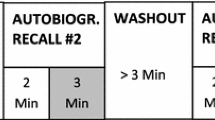Abstract
EEG signals are established to be highly effective in spontaneous emotion recognition while subjects are exposed to some stimuli. However, it is posited that the neural signature of posed (volitional/deliberate) emotions are varying from their spontaneous counterpart. In this study, we present subject dependent analysis of spontaneous and posed emotional evocations using normalized time-intensities of higher frequency rhythms. The time-intensities with respect to posed and spontaneous neutral, happy and sad emotions are calculated and topographic distributions are plotted. The topographic time-intensity plots of subjects with respect to posed and spontaneous emotions inferring the prevailing left cerebral activation in posed evocation as compared to coherent right cerebral activation of electrodes in case of spontaneous emotional evocation.
Access this chapter
Tax calculation will be finalised at checkout
Purchases are for personal use only
Similar content being viewed by others
References
N.S. Suhaimi, J. Mountstephens, J. Teo, EEG-based emotion recognition a state-of-the-art review of current trends and opportunities. Computational Intelligence Neuroscience, 16, 20208875426. http://doi.org/10.1155/2020/8875426. PMID 33014031; PMCID PMC7516734 (2020)
R. Sarno, M.N. Munawar, B.T. Nugraha, Real-time electroencephalography-based emotion recognition system. Int. Rev. Comput. Softw. (IRECOS) 11(5), 456–465 (2016)
J. Yan, S. Chen, S. Deng, A EEG‑based emotion recognition model with rhythm and time characteristics. Brain Inf. 67 (2019). http://doi.org/10.1186/s40708-019-0100-y
W.L. Zheng, B.L. Lu, Investigating critical frequency bands and channels for EEG based emotion recognition with deep neural networks. IEEE Trans. Auton. Mental Dev. 7(3), 1 (2015)
C. Liu, P. Rani, N. Sarkar, An empirical study of machine learning techniques for affect recognition in human-robot interaction, in Proceedings of the IEEE/RSJ International Conference on Intelligent Robots and Systems, IROS, Sendai, Japan (2005)
G. Rigas, C.D. Katsis, G. Ganiatsas, D.I. Fotiadis, A User Independent, Biosignal Based, Emotion Recognition Method. Springer, Berlin, Germany (2007)
C. Zong, M. Chetouani, Hilbert-Huang transform based physiological signals analysis for emotion recognition, in Proceedings of the IEEE International Symposium on Signal Processing and Information Technology, ISSPIT, Ajman, UAE (2009), pp. 334–339
L. Li, J.H. Chen, Emotion recognition using physiological signals from multiple subjects, in Proceedings of the International Conference on Intelligent Information Hiding and Multimedia, Pasadena, CA, USA (2006), pp. 437–446
F. Nasoz, K. Alvarez, C.L. Lisetti, N. Finkelstein, Emotion recognition from physiological signals using wireless sensors for presence technologies. Cogn. Technol. Work 6(1), 4–14 (2004)
A. Haag, S. Goronzy, P. Schaich, J. Williams, Emotion recognition using bio-sensors first steps towards an automatic system. Lecture Notes in Computer Science. Springer, Berlin, Germany (2004)
J. Kim, E. Andre, Emotion recognition based on physiological changes in music listening. IEEE Trans. Pattern Anal. Mach. Intell. 30(12), 2067–2083 (2008)
R. Du, R.M. Mehmood, H.J. Lee, Alpha activity during emotional experience revealed by ERSP. J. Internet Technol. 15(5), 775–782 (2014)
P. Zhou, J. Wei, S. Liu, J. Meng, X. An, H. Qi, F. He, X. Wang, M. Scott, D. Ming, M. Liu, The intensity recognition of tension emotion based on multi-physiological signals. Journal of Psychiatry and Brain Science (JPBS) 5(1), 1–6 (2016). https://doi.org/10.20900/jpbs.20160019
P.J. Lang, M.M. Bradley, B.N. Cuthbert, International Affective Picture System (IAPS) Technical Manual and Affective Ratings. NIMH Center for the Study of Emotion and Attention, Gainesville, FL (1997)
M. Bradley, P. Lang, The international affective digitized sound (IADS-2) affective rating of sounds and instruction manual. Technical Report, University of Florida (2007)
H. Jasper, The ten-twenty electrode system of the international federation. Electroencephalogr. Clin. Neurophysiol. 39, 371–375 (1958)
A. Delaurme, S. Makeig, EEGLAB an open source toolbox for analysis of single trial EEG dynamics including independent component analysis. J. Neurosci. Methods 134(1), 9–21 (2004)
Author information
Authors and Affiliations
Corresponding author
Editor information
Editors and Affiliations
Rights and permissions
Copyright information
© 2022 The Author(s), under exclusive license to Springer Nature Singapore Pte Ltd.
About this paper
Cite this paper
Joshi, R., Sen, P., Ingle, M. (2022). Analyzing Frequency Rhythms in Posed and Spontaneous Emotions Using Time-Intensity of EEG Signals. In: Rathore, V.S., Sharma, S.C., Tavares, J.M.R., Moreira, C., Surendiran, B. (eds) Rising Threats in Expert Applications and Solutions. Lecture Notes in Networks and Systems, vol 434. Springer, Singapore. https://doi.org/10.1007/978-981-19-1122-4_28
Download citation
DOI: https://doi.org/10.1007/978-981-19-1122-4_28
Published:
Publisher Name: Springer, Singapore
Print ISBN: 978-981-19-1121-7
Online ISBN: 978-981-19-1122-4
eBook Packages: Intelligent Technologies and RoboticsIntelligent Technologies and Robotics (R0)




